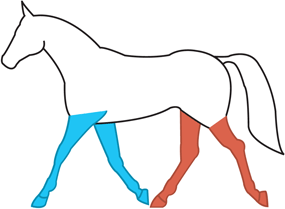Determining which leg is lame

Except in severe lameness, assessment takes place when the horse trots. It is more common to examine a horse’s gait for lameness in front when it is coming towards you and hind limb lameness when it is going away.
In general a horse will drop its weight onto the unaffected leg. The head will appear to nod onto this leg.
Forelimb lameness
With left forelimb lameness, for example, the horse will come down more heavily onto the right foreleg and its head will appear to nod onto this leg. The horse's head goes 'down' on the sound leg.
Hindlimb lameness
This is more challenging to diagnose. Looking from behind, with a left hindlimb lameness, the hip goes through a greater range of vertical motion and appears to be carried higher than the right hindleg.
It is possible that the head will drop onto the opposite (right) foreleg.

